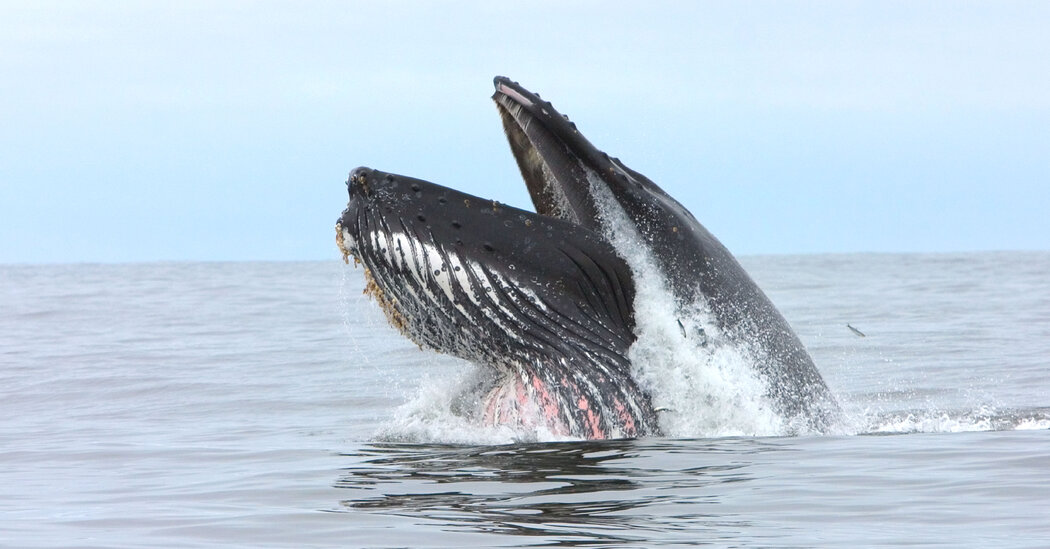Scientists have discovered a new anatomical structure that allows lunge-feeding whales to take in massive amounts of water without choking.
To capture prey, humpbacks, minkes and other whales use a tactic called lunge feeding. They accelerate — their mouths open to nearly 90 degrees — and engulf a volume of water large enough to fill their entire bodies. “It’s crazy. Imagine putting an entire human inside your mouth,” said Kelsey Gil, a zoologist studying whale physiology at the University of British Columbia.
As water floods into the whale’s mouth, its throat pouch expands, leaving the whale looking like a bloated tadpole. After about a minute, the throat pouch deflates as most of the water leaves the whale’s mouth, released back into the ocean. Small fish and krill are captured in the whale’s baleen — plates of keratin that hang from the top of the whale’s mouth resembling bristles on a toothbrush — and are swallowed into the whale’s stomach.
Scientists didn’t know how these whales avoided choking on prey-filled water and flooding their respiratory tracts during a lunge feeding event. Now Dr. Gil and colleagues have discovered a large, bulbous structure that they’ve termed the “oral plug” — a structure never before described in any other animal — that they think makes lunge feeding possible. Their results were published Thursday in Current Biology.
Lunge-feeding whales are also called rorqual whales and include two of the largest animals on Earth — the blue and fin whales. Through lunge feeding, rorqual whales ingest thousands of pounds of food every day, a feeding strategy that allows them to maintain their hulking physiques, which can weigh more than 300,000 pounds in the case of blue whales.
To determine how these whales are safely chowing down — and not choking — on their food, Dr. Gil and colleagues analyzed deceased fin whales. When opening up the mouth of the first whale, they were confused by what they saw.
“If you look in the mirror at the back of your throat, it’s just a big empty space,” Dr. Gil said. “But when we were looking in the back of this whale’s mouth, there was this space that was just plugged with tissue, and we thought, ‘That doesn’t make sense. That’s where food has to travel through — why is it being blocked off like that?’”
By physically manipulating and dissecting the mass of muscle and tissue — the oral plug — the researchers determined that when the animal is at rest, the plug blocks off the whale’s pharynx, a tube-shaped structure that leads to both the respiratory and digestive tracts, just like in other mammals including humans. When a whale lunges, the oral plug protects both tracts from being flooded by the water and the critters that the animal has taken in.
For the whale to ingest food, that oral plug needs to move. Again through manipulation and dissection, the researchers figured out that when the animal was ready to swallow its latest meal, the oral plug shifted upward to protect the upper respiratory tract, including the nasal cavities and blowhole. At the same time, the larynx — the structure in the pharynx that guards the entrance to the lungs — closes up and shifts downward, sealing off the lower respiratory tract. In other words, during swallowing, the pharynx only leads to the digestive tract and the upper and lower airways are protected.
“This fills in a blank that we didn’t even know really existed,” said Dr. Gil of the team’s findings.
Ari Friedlaender, who studies whale feeding behaviors at the University of California, Santa Cruz but was not involved in this research, sees immense value in filling in these anatomical blanks about whales.
“The more we can understand how they developed these means for being able to eat so much, and to be so efficient as foragers, the more we understand about what their capacities are, and how they function as part of marine ecosystems,” Dr. Friedlaender said. “It’s sort of the ultimate evolution of anatomy to be able to do these things that no other animals can do.”


























